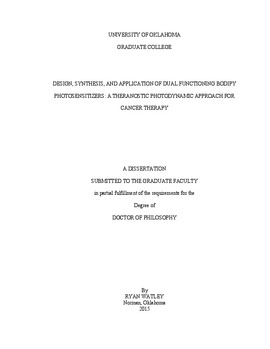| dc.description.abstract | Development of concomitant photodynamic therapy (PDT) and photosensitizer fluorescence detection (PFD), termed theranostics, is of primary interest as combining the two modalities stands to offer a more personalized cost effective “see, treat, and monitor” approach. As a minimally invasive drug-device strategy, the standard protocol involves photosensitizer (light sensitive drug) or fluorophore administration followed by light activation. Specifically, PDT is an approved regimen for the treatment of non-malignant and neoplastic disease. The cytotoxic effect derives from an activated photosensitizer reaction with local oxygen, which produces a tumor damaging species known as singlet oxygen. PFD employs a fluorophore as an invaluable tool for monitoring photosensitizer bio-distribution along with delineating healthy and diseased tissue in the native environment. The two, PDT and PFD, are distinguished via competing photochemical mechanism of administered drugs, which in part hampers their combined application.
A photosensitizer’s therapeutic efficacy is invariably linked to intersystem crossing, which attenuates fluorescence required for imaging. Improving fluorescence yield of photosensitizer’s stands to impart information concerning drug location and concentration. These parameters are vital for determining the optimal time of illumination within PDT. Furthermore, fusion of PDT and PFD enables impromptu eradication of detected disease and subsequent monitoring of photodynamic response when targeted photosensitizers are used.
This dissertation explores the design and synthesis of NIR dual functioning mono-BODIPY photosensitizers for optical image-guided PDT. The synthetic methodology excludes conventional incorporation of halogens as heavy atoms, which alter photophysical properties. Moreover, identification of the key structure photophysical property relationship for obtaining both effective fluorescence and singlet oxygen generation was uncovered along with elucidation of the photochemical mechanism. Above all, application through fluorescence bio-distribution studies and whole body in vivo imaging facilitates more effective tumor ablation through optimizing drug-light intervals for PDT.
The objective of this dissertation is to develop NIR BODIPY photosensitizers applicable for imaging and therapy with one PS. Chapter I describes ingenious efforts to develop NIR BODIPY dyes, yet none have surfaced as dual agents for fluorescence detection and therapy. In addition, Chapter I highlight functionalization of NIR BODIPY dyes for improving water solubility, and tethering to cancer specific biomolecules.
In Chapter II, citing the weak fluorescence of porphyrin based PS and populated triplet state of BODIPY fluorophores, intersystem crossing and production of singlet oxygen was accomplished without the use of heavy halogen atoms such as Br and I. The heavy atom effect significantly reduces the fluorescence, thus limiting its dual-application. BODIPY and thiophene units were fused for extended conjugation with varying electronic effects. An investigation into the structure photophyscial property relationship concluded electron-withdrawing groups enable singlet oxygen generation absent conventional heavy atom incorporation. The lead compound, SBDPiR690 has an inherent brightness and phototoxic power of 26,400 M-1cm-1 and 50,400 M-1cm-1, respectively. The design and synthesis of several analogs resulted in an improved SBDPIR688 analog with a brightness of 37, 440 M-1cm-1 and phototoxic power of 45,120 M-1cm-1.
Chapter III demonstrates the translation of our lead compound SBDPiR690 photo physical properties in vitro and in vivo. Specifically, concentration dependence on cell survival illustrates minimal dark toxicity at the cell monolayer. Furthermore, brightness of the parent compound proved advantageous for non-invasive imaging of bio-distribution. The pharmacokinetic pattern helps establish an optimal drug light interval for vascular-targeted PDT, which was successful in total eradication of sub-cutaneous colon 26 tumor.
In Chapter IV, we modify parent compounds through incorporating functional groups potentially facilitating improved aqueous solubility and overall improved pharmacokinetics. The inclusion of ester moieties through substitution of the boron center disrupts singlet oxygen generation in our improved analog SBDPiR688. However, ester synthons at the peripheral sites of the lead compound SBDPiR690 maintain its therapeutic capability through singlet oxygen generation. The ester functionality offers potential conjugation of target specific ligands for improved pharmacodynamics. | en_US |
